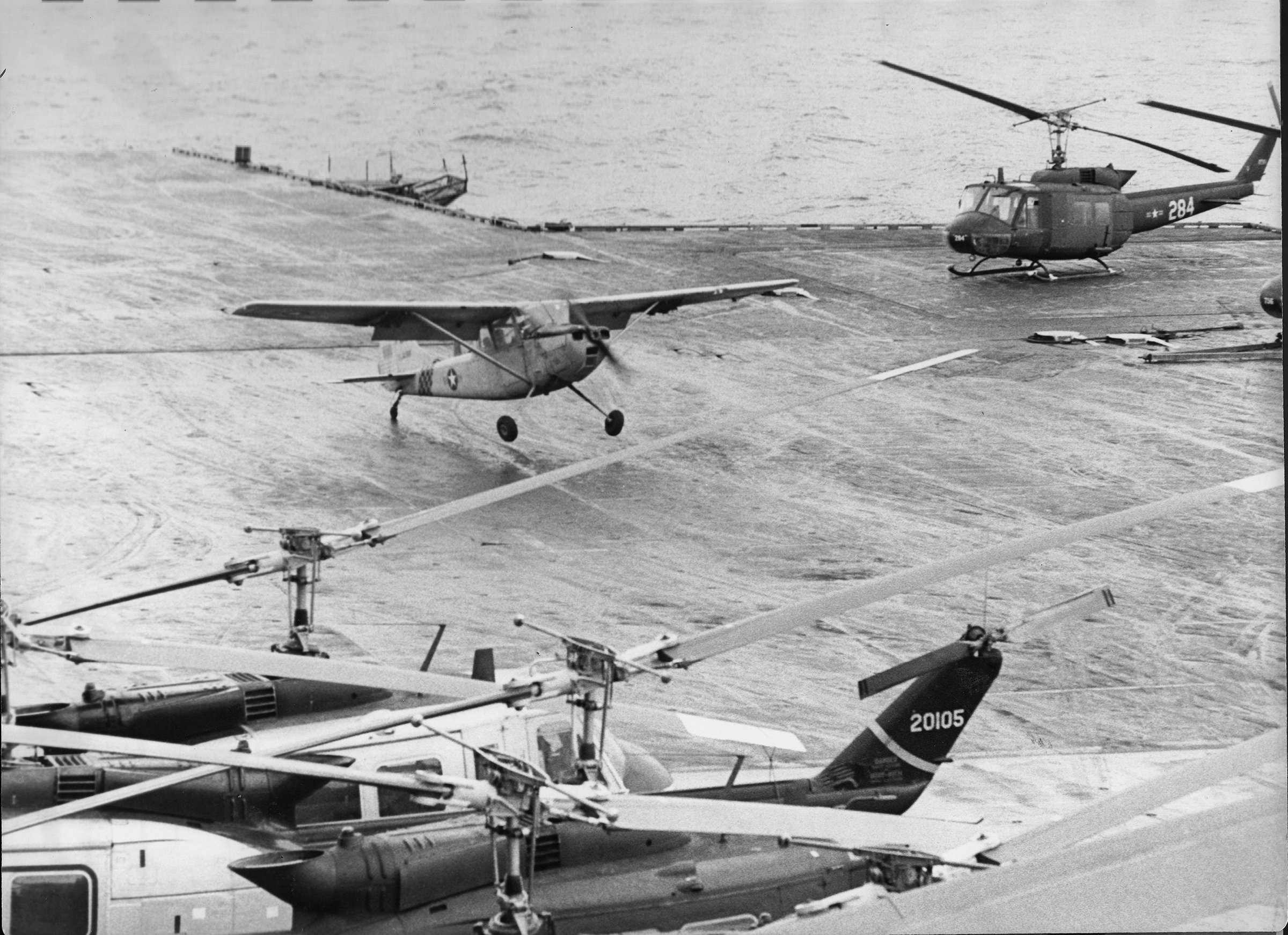As his country crumbled, a South Vietnamese pilot attempting a high-risk landing on the Midway depended on the ship’s quick-thinking crew to save his family from disaster.
On the last full day of his country’s existence, South Vietnamese air force Maj. Buang-Ly stole a tiny two-seat airplane. He helped his wife and their five children, ages 14 months to 6 years, into the backseat and storage area before climbing into the pilot’s seat. They took off and headed out to sea while enemy ground fire zipped past them.
It was April 29, 1975, and chaos had enveloped the nation. Two years earlier, the 1973 Paris peace agreement had theoretically ended the war, but after American combat forces left the country, the North Vietnamese took the opportunity to press their new strategic advantage. The long war between North and South Vietnam paused only briefly before ferocious fighting resumed.
In early 1975, the North Vietnamese Army seized key bases in the Central Highlands, and, by the end of March, had captured areas along the coast. The remaining American advisers and many South Vietnamese families began frenzied evacuations on American military aircraft and civilian transport planes.
Those large, fixed-wing aircraft flew thousands of people to hastily constructed camps in the Philippines, Guam and Wake Island. The last plane out of Da Nang, a civilian Boeing 727 on March 29, was unable to retract its landing gear in flight because at least seven of the 290 passengers had climbed into its wheel wells. Soon North Vietnamese forces were shelling Saigon.

Buang and his family were stationed on Con Son Island, about 50 miles off the southern coast and home to one of the last bases still under South Vietnamese control. Used mainly as a prison camp, the island also had a small airfield. When Buang and his wife learned that North Vietnamese forces were closing in, they loaded as many of their possessions as possible into the plane and got airborne—with no plan for what to do next.
Their tiny aircraft, an O-1 Bird Dog, was a modified Cessna 170, a light, single-engine tail dragger with fixed landing gear. Ruggedly built and highly maneuverable, Bird Dogs flew over South Vietnam’s terrain during the war, spotting enemy targets and then marking them with white phosphorous rockets to guide U.S. artillery shelling and airstrikes. The planes could take off and land on a dime, but their range was limited to just over 500 miles when fully fueled—and Buang’s fuel tank was not.
As Buang coaxed the overloaded plane airborne, he faced enormous challenges. The Bird Dog was not designed to operate over water. It lacked sophisticated navigation equipment, life vests and the ability to safely ditch in an emergency. Buang had never seen, much less landed on, an aircraft carrier—and to make matters worse, this Bird Dog had no working radio because Buang had not been able to bring a headset. Still, he knew that his family was more likely to find safety out at sea, where the U.S. Navy was in control, than on the land now controlled by communist forces under Gen. Van Tien Dung.
After flying for a half-hour, Buang spotted a gaggle of helicopters in the distance heading east. At the time he had no idea they were loaded with friendly evacuees, but it seemed like a good idea to follow them. “I was searching for a safe place,” Buang later recalled. “It made me think there was something out there they could depend on.”
On April 19, 10 days before the Buang family departed Con Son Island, the aircraft carrier USS Midway had received orders to leave Naval Station Subic Bay in the Philippines and make best speed toward Saigon to help evacuate the roughly 5,000 Americans remaining there, including diplomats, CIA agents, contractors and a handful of Marines. Midway and the rest of the 7th Fleet would also evacuate as many friendly Vietnamese as possible.
The old ship had been in service since September 1945 and was just starting a pier side repair period. Its engineering plant, which had been taken offline for maintenance, needed to be hastily restored to operation, and the ship got underway with fewer sailors than normal. At Subic Bay, Midway offloaded half of the fixed-wing jets in its combat air wing. When the ship reached the South China Sea, it received 10 large Sikorsky H-53 helicopters—two U.S. Air Force HH-53s from the 40th Aerospace Rescue and Recovery Squadron and eight CH-53s from the Air Force’s 21st Special Operations Squadron. Each of these choppers could comfortably transport 55 passengers at a time.
The mission, dubbed Operation Frequent Wind, would employ an ad-hoc fleet of helicopters and several elements of the 7th Fleet—an impressive array of combat vehicles—to conduct a massive humanitarian operation, transporting and caring for thousands of refugees. During transit, the carrier’s crew got busy training for the work ahead.
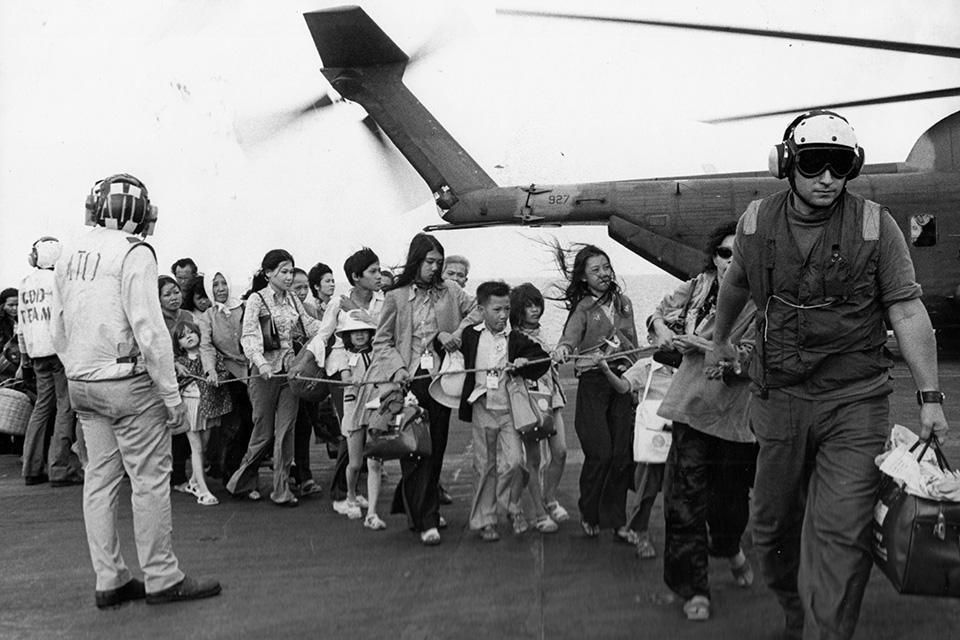
Throughout the war, most air operations from carriers like Midway had been combat sorties: bombing, intelligence gathering and combat air patrol. Noncombat logistics operations normally took up only a small slice of a day’s action on the flight deck. The logistics crews usually transferred a few dozen passengers a day, maybe brought onboard a new jet engine or other supplies, and shipped mail via plane or helicopter.
Typically, a junior air transfer officer leading a crew of about a dozen sailors could easily handle the load. But for Operation Frequent Wind, the entire ship and its crew were devoted to the effort. The carrier’s senior enlisted sailors led the rest of the crew in drills designed to account for every imaginable problem.
On the morning of April 29, former South Vietnamese Prime Minister and Vice President Nguyen Cao Ky, accompanied by Lt. Gen. Ngo Quang Truong, requested permission to land on the Midway, after making a one-hour, 15-minute helicopter flight from the mainland. Their arrival signaled to the carrier’s officers that Operation Frequent Wind had begun. About 11 a.m. that morning Secretary of State Henry Kissinger finally gave American diplomats the order to evacuate. An American radio station broadcast the secret signal: “The temperature in Saigon is 105 degrees and rising,” followed by Tennessee Ernie Ford’s “White Christmas”—because the DJ couldn’t find the more well-known Bing Crosby version. The signal told evacuees in Saigon to move to pre-assigned extraction locations, board buses there and head to the airport.
As the official evacuation commenced, many resourceful Vietnamese commandeered whatever aircraft they could to fly to safety. “At least 74 planes of the South Vietnamese Air Force, including about 30 F-5 fighters, streamed into the U Taphao air base in southern Thailand from South Vietnam without warning,” The New York Times reported the next day. “The pilots and passengers—about 2,000 people—requested asylum,” and more planes kept arriving. Thai officials declared their intention to return the aircraft to South Vietnam, which soon became impossible as the South was absorbed into a unified Vietnam under Hanoi’s communist leadership.
More choppers began arriving on Midway’s flight deck. The ship’s contingent of Marines and the sergeant at arms searched the new arrivals for contraband and weapons, confiscating pistols and wads of worthless South Vietnamese cash that they threw over the side. Then they helped passengers into the ship’s command structure on the starboard side, known as “the island,” where crew members gave them food and basic medical care. All but 80 or so of the most dire cases were transferred by helicopter to other ships to be distributed across the whole fleet, a process that went on well into the next day.
Young, tough sailors who were used to handling bombs, chains and fuel lines amid the roar of jet engines now devoted themselves to caring for bewildered parents, frightened children, the elderly and the sick. The flight deck was choked with choppers and lines of men and women carrying suitcases and children. The hangar bay below decks ran out of room for more aircraft as efforts to aid hundreds of refugees continued there.
The Midway was commanded by Capt. Lawrence Chambers, the first African-American carrier captain and just the second to graduate from the U.S. Naval Academy when he earned his degree in 1952. Chambers had reported aboard the carrier in January 1975 and been in command for only a few weeks. In a television interview 35 years later, he recalled the scene as he watched from his chair on the bridge, just above the action: “A flight deck is a hazardous operation under normal conditions. And when you see little kids and mothers holding little babies, and airplanes, helicopters are taking off and landing, you just kind of hold your breath.”
Weather conditions were not ideal, observed the ship’s air boss, Cmdr. Vern Jumper, from his perch five stories above the flight deck in the Primary Flight Control room. Jumper was responsible for all aspects of flight operations, including any aircraft flying near the ship, all the action on the flight deck, and the work happening down in the hangar bay. He noted rain falling from a 500-foot cloud ceiling, 15 knots (17 mph) of wind over the deck and 5 miles visibility. But the seas remained relatively calm, which meant the deck, though sometimes slick with water, wasn’t pitching.
Air traffic controllers inside the ship and landing signals crew on deck used whatever means necessary to keep helicopters in order as they approached. Communication went smoothly with the 10 H-53 helicopters that were part of the operation. They would land, unload, refuel and make repeated trips to Saigon. By mid-afternoon, an additional 45 UH-1 Iroquois “Huey” helicopters had arrived from the mainland. Most had no ability to communicate with the ship via radio. “We were using hand signals to the pilots to control where they landed on the flight deck,” Jumper recalled 35 years later. Sailors and aircrews also communicated via signal flags and colored signal lamps—red, don’t land; green, OK to land.
Every pilot managed his fuel and waited patiently for his turn. At one point, Jumper and his assistant, Cmdr. Pete Theodorelos, counted 26 helicopters circling the carrier while sailors assisted waves of arriving passengers. As soon as a chopper’s rotors stopped twirling, sailors pushed it away from the action, using small rectangular tractors or brute manpower. By packing the incoming aircraft close together, they were able to recover them all. None had to ditch next to the carrier, but the flight deck soon filled to capacity.
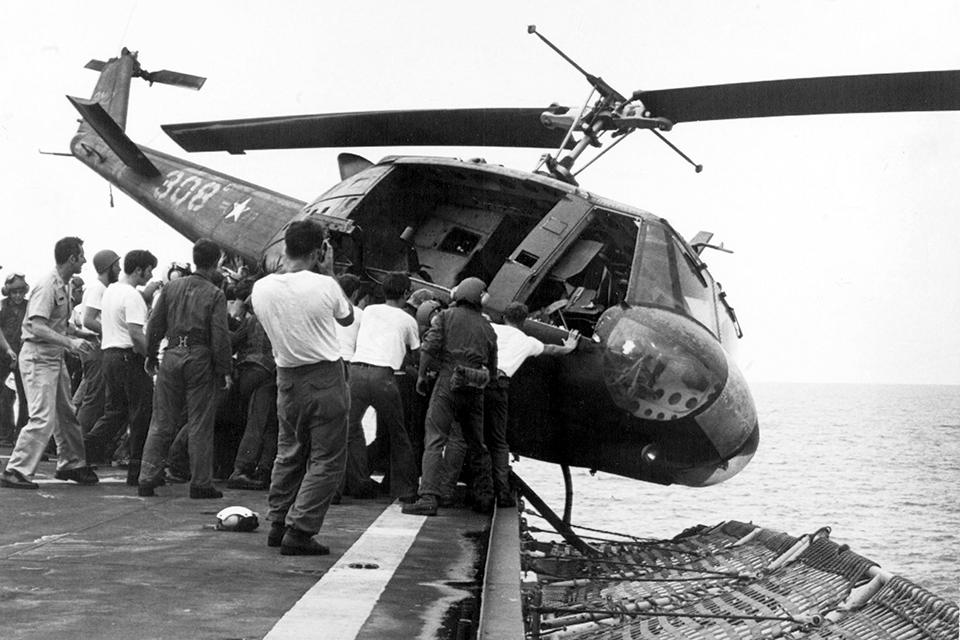
Toward the end of that wild afternoon, spotters on the carrier saw a tiny two-seat Cessna come into view. Through binoculars they counted at least four people in the plane, which had South Vietnamese markings. The Bird Dog began circling overhead with its landing lights switched on. Periodically the pilot rocked the plane’s wings. A Vietnamese translator was rushed to Primary Flight Control to join Jumper and Theodorelos in the ship’s tower, but attempts to radio the plane were met with static. From the bridge Chambers quickly consulted task force commander Adm. William Harris, who was at his battle station below deck.
“The admiral ordered me to tell the Bird Dog to ditch,” Chambers later recalled. A helicopter could be dispatched to drop swimmers in the water and rescue the occupants. Other pilots flying choppers near the rest of the 7th Fleet were putting their aircraft into the sea. They hovered to drop passengers onto the fleet’s smaller ships, including destroyers and supply craft. When all passengers had safely left a chopper, the pilot would maneuver away and steer the machine on a course to safely ditch into open water. At the last moment he would jump clear of the rotors and drop into the sea, then swim toward the nearest vessel.
However, the fixed-wing Bird Dog couldn’t hover to drop off its passengers, and its fixed landing gear would cause the plane to flip onto its back as soon as the wheels touched the water. Only a well-trained crew member, properly strapped in, would get out alive. If the plane was ditched, the rest of its occupants had almost no chance.
“My judgment told me, if I didn’t give him a chance to land that he was going to crash it on the deck,” Chambers said.
As the Bird Dog circled, the pilot dropped three paper notes from the plane, but they blew over the side before the ship’s crew could snatch them. On the next pass he stuffed a fourth note into his pistol’s leather holster to weigh it down, and sailors rushed to grab the little package after it hit the deck. They read a scribbled message written on a crumpled chart of South Vietnam: Can you mouve [sic] these Helicopter to the other side, I can land on your runway, I can fly 1 hour more, we have enough time to mouve. Please rescue me. Major Buang wife and 5 child.
The message was quickly relayed to the bridge where Chambers was discussing the situation with Jumper over the phone. Ignoring pressure from the admiral, Chambers decided to do whatever was necessary to let the Bird Dog land, even if that meant throwing millions of dollars worth of equipment over the side and possibly being relieved of his command.
“Vern,” Chambers said into the phone, “give me a ready deck.” Jumper called for all available crewmen and volunteers to help prepare the angled flight deck for the Cessna. Meanwhile, with six boilers offline for maintenance, Chambers ordered his chief engineer to transfer the ship’s electric load to the emergency diesel engines and make steam for 25 knots (29 mph).
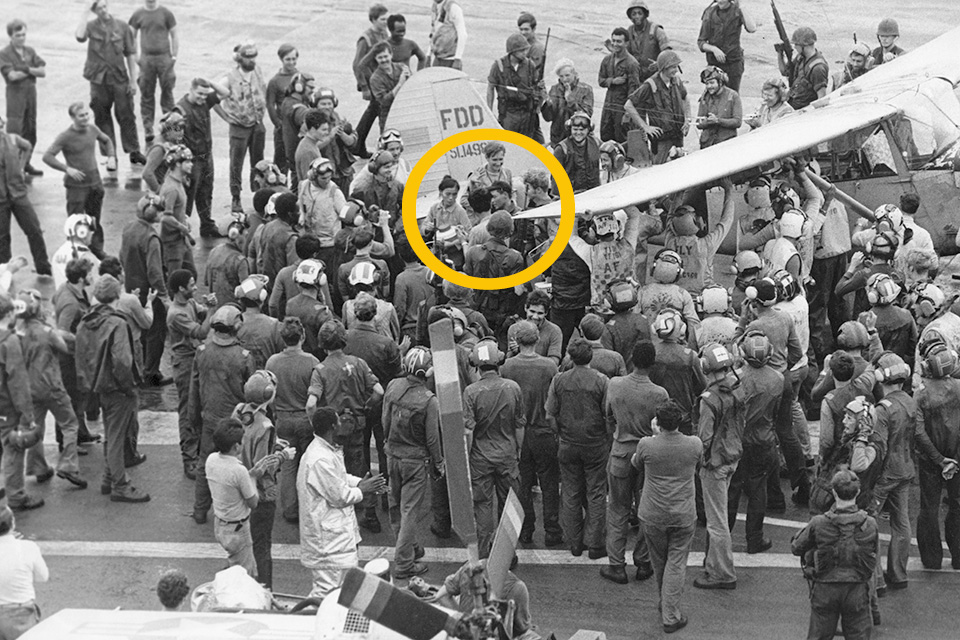
The captain turned his ship into the wind to prepare for a fixed-wing landing. Fire crews readied their hoses and donned fire-retardant suits. Since the Bird Dog had no tail hook, sailors removed the four landing cables that normally spanned the runway. Other crew members leaned in together to heave three Hueys and one Chinook over the side. When their skids went over the flight deck’s edge, the empty choppers nosed up, twisted, then fell backward into the sea with big splashes.
Immediately, five more airborne Huey pilots took advantage of the cleared runway to land and disembark their passengers. Assuming he would be court martialed, Chambers ordered those helicopters thrown overboard as well. He later told interviewers that since he expected to be deposed by prosecutors, he turned away from the action to avoid seeing exactly how many were pushed into the sea. In the same interview Jumper also claimed not to know how many helicopters went overboard.
The old ship rattled and groaned as its speed increased. Jumper gave the green lamp signal to land. Buang made two practice passes over the ship to get a feel for the approach while translators—in English and Vietnamese—tried to warn him about the dangerous downdrafts that naturally occur behind the ship’s fantail. With no response, the crew could only watch, hoping that he would carry enough power to fly through that turbulence.
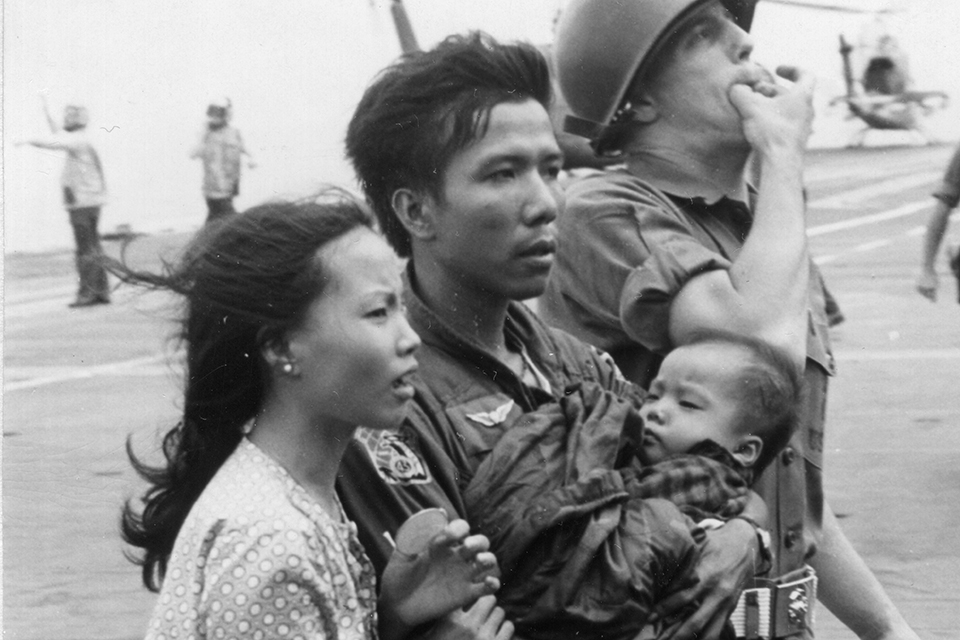
Buang lowered the Bird Dog’s flaps and approached in a shallow descent at a speed of 60 knots (69 mph). With the ship providing an estimated 40 knots (46 mph) of headwind to aid the landing, the light plane slowly caught up. It seemed to flutter for a moment just above the deck, then bounced once in the landing area and rolled to a smooth stop in the middle of the runway.
Dozens of sailors ran toward the plane to grab it in case the aircraft’s momentum was enough to send it over the side, but the Bird Dog stayed where it had stopped. A hodgepodge of squadron crew and ship’s company weighed the plane down with their bodies while Buang and his wife, carrying their youngest child, climbed out of the cockpit. He pulled forward the seat and out tumbled the other four children. Cheers rang out and sailors clapped while the family walked into the ship’s island.
Altogether, 71 American helicopters flew a total of 662 sorties from Saigon to the 7th Fleet’s ships, rescuing more than 7,800 people. The 10 Air Force H-53s flew four round trips from the Midway to Saigon, evacuating more than 1,400 personnel from the start of the operation on the morning of April 29 until its end at 9 a.m. on April 30. Three hours later, South Vietnamese Gen. Duong Van Minh surrendered Saigon to North Vietnamese Col. Bui Tin, effectively ending the war—as well as the nation of South Vietnam.
The Bird Dog Buang-Ly flew that day now hangs at the National Naval Aviation Museum in Pensacola, Florida. Chambers kept his job as the aircraft carrier’s captain and was later promoted to rear admiral; he retired in 1984. Nobody was prosecuted for the estimated $10 million loss of the helicopters that Chambers ordered overboard. The Midway’s crew collected money to help ease the transition for the Buang family, who became seven of the estimated 130,000 refugees from the Vietnam War to eventually resettle in the United States. All seven are now naturalized American citizens.
Paul X. Rutz is an artist and freelance writer. A 2001 graduate of the U.S. Naval Academy, he served aboard the aircraft carrier USS John F. Kennedy.
This article appeared in the June 2019 issue of Vietnam magazine.

